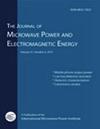Comparison of the effect of changing the spatial distance with exposure time to mobile phones radiation on the structure and function of the testis in NMRI mice
IF 1.5
4区 工程技术
Q4 ENGINEERING, CHEMICAL
Journal of Microwave Power and Electromagnetic Energy
Pub Date : 2022-04-03
DOI:10.1080/08327823.2022.2066769
引用次数: 0
Abstract
Abstract The present study was conducted to compare the effect of changing the spatial distance and time radio frequency (RF) radiation from mobile phone in standby mode on the structure and function of testicles. NMRI mice were randomly divided into three groups. The first group was the control and the second group (exposed group) was divided into four subgroups: groups A (A1 and A2) and groups B (B1 and B2), which were placed in plastic holder units at two distances of 5 cm and 20 cm from RF radiation, respectively. A1 and B1, and A2 and B2 were exposed to RF radiation for six and 10 weeks, respectively. The exposure duration was 5 days/week, 6 hours/day. The third group with two subgroups (sham1 and sham2) were kept in plastic holder units without being exposed to radiation and were evaluated after six and 10 weeks, respectively. The changes in the external diameters of seminiferous tubules and the height of germinal epithelium obviously depended more on the distance from the radiation source than on the exposure time. The decrease in the diameter of the testicles and sperm motility were found to be time-dependent. These effects had a clear but unpredictable dependence on the two variables of distance and RF radiation time.改变手机辐射空间距离和暴露时间对NMRI小鼠睾丸结构和功能影响的比较
摘要本研究旨在比较手机待机状态下改变手机空间距离和时间射频辐射对睾丸结构和功能的影响。NMRI小鼠随机分为三组。第一组为对照组,第二组(暴露组)分为4个亚组:A组(A1和A2)和B组(B1和B2),分别放置在距离射频辐射5厘米和20厘米的两个塑料支架上。A1和B1, A2和B2分别暴露于射频辐射6周和10周。暴露时间为5天/周,6小时/天。第三组有两个亚组(sham1和sham2),被保存在塑料支架中,没有暴露在辐射中,分别在6周和10周后进行评估。精小管外径和生发上皮高度的变化与辐照距离的关系大于辐照时间的关系。研究发现,睾丸直径和精子活力的减少与时间有关。这些影响对距离和射频辐射时间这两个变量有明显但不可预测的依赖性。
本文章由计算机程序翻译,如有差异,请以英文原文为准。
求助全文
约1分钟内获得全文
求助全文
来源期刊

Journal of Microwave Power and Electromagnetic Energy
ENGINEERING, CHEMICAL-ENGINEERING, ELECTRICAL & ELECTRONIC
CiteScore
2.50
自引率
6.70%
发文量
21
期刊介绍:
The Journal of the Microwave Power Energy (JMPEE) is a quarterly publication of the International Microwave Power Institute (IMPI), aimed to be one of the primary sources of the most reliable information in the arts and sciences of microwave and RF technology. JMPEE provides space to engineers and researchers for presenting papers about non-communication applications of microwave and RF, mostly industrial, scientific, medical and instrumentation. Topics include, but are not limited to: applications in materials science and nanotechnology, characterization of biological tissues, food industry applications, green chemistry, health and therapeutic applications, microwave chemistry, microwave processing of materials, soil remediation, and waste processing.
 求助内容:
求助内容: 应助结果提醒方式:
应助结果提醒方式:


